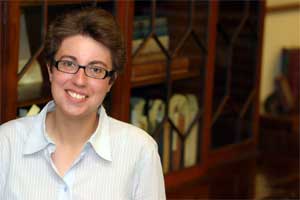 |
| Julia Poertner: "If you mention Dalhousie in Germany, people will know of it." (Pearce photo) |
In Germany, the family of literary lion Thomas Mann attracts the same kind of public fascination that the Trudeau family commands in Canada, or the Kennedys in the United States. You can never really know too much about them.
But when German student Julia Poertner wanted to find out more about the Mann family, or about Thomas MannÕs youngest daughter Elisabeth in particular, she had to come to Dalhousie.
Her curiosity was piqued by a three-part docudrama on the family Ñ The Manns: Novel of a Century Ñ that aired on German television several years ago. Billed as Òthe saga of an extraordinary family that stamped its country, its culture and its era like no other,” the six-hour miniseries includes commentary by Elisabeth, who is seen strolling through her childhood home in Munich and at various locations where the family lived during their wartime flight from Nazi Germany.
Sambro Head home
Thomas Mann (1875-1955) married Katja Pringsheim in 1905 and they had six children Ñ Erika, Klaus, Golo, Monika, Elisabeth and Michael Ñ all of them brilliant writers and intellectuals in their own right.
ÒElisabeth never wanted to base her career on having a famous father,” says Ms. Poertner, 24, from Bremen, Germany. ÒBut when she was the only Mann left, she started talking.”
For the past several months, the masterÕs student has been camped out on the fifth floor of the Killam Library, where sheÕs been pouring over ElisabethÕs letters, manuscripts, and photographs. The collection was donated to Dalhousie after ElisabethÕs death at the age of 83 during a ski trip in the Alps in 2002.
Elisabeth moved with her family to the United States in 1938. The following year, she married Giuseppe Borgese, with whom she was active in the Chicago School of international scholars, which provided much of the intellectual underpinnings for the world federalist and United Nations reform movements.
In 1978, she relocated to Dalhousie University, where she taught courses in political science and continued to work on projects relating to disarmament, international development, integration of marine resources and marine management. She lived by the ocean in an old home in Sambro Head along with her beloved dogs, which she taught to play piano and even type.
Science fiction writing
ÒIf you mention Dalhousie in Germany, people will know of it,” says Ms. Poertner. ÒThey know the name because it is connected to Elisabeth.”
As a student of German literature, Ms. Poertner is interested in ElisabethÕs fiction writing. She wrote two short story collections, To Whom It May Concern, published in 1959, and How Gottlieb Hauptmann Abolished the Death Penalty, published only in Germany in 2001. She also wrote plays, including Only the Pyre and Eat Your Fishballs, Tarquin.
During her lifetime, Elisabeth was known for her incredible energy and optimism. And yet her fiction writing reveals quite a different side.
ÒHer short stories tend to be very dark and pessimistic, exploring the role of science and how misguided it is,” says Ms. Poertner. ÒShe once said she needed her short stories to go on with her work in real life.”
